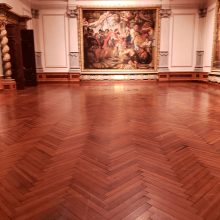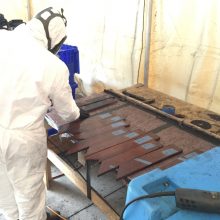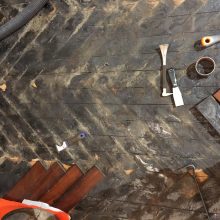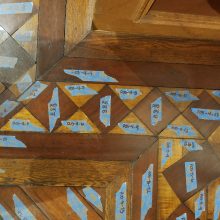Art Museum Gallery Wood Floor Restoration
Gallery 2 of the John & Mable Ringling Museum of Art houses some of the museum’s most significant works by Peter Paul Rubens, the great Flemish Baroque painter. Visitors are awed to find these treasures, part of a series of which the remainder are on display at the Louvre in Paris, in a Florida museum. The purpose-build gallery was created to match the splendor of the holdings. A unique tropical hardwood was used for the floor, laid in a herringbone design with an ornate geometric pattern border. The wood was so hard and durable that the original fabricators had to cut it without the normal tongue and groove floor detailing as their saws could not stand up to the wear. As a result, the slats were not keyed together but held in place only by a bituminous adhesive. This eventually dried out and failed, leaving the slats loose.
EverGreene was contracted to treat the Gallery 2 Floor within the Museum of Art. Onsite assessment was completed by our conservators in January 2019. The goal of the treatment was to clean and re-adhere the tropical hardwood floor slats which had become loose and a trip hazard with minimal disturbance to the art.
Substantial efforts went into devising methods of restoring the floor without risking the priceless Rubens paintings and other works of art within the gallery that could not be moved during work. A double wall enclosure was constructed around the work area with air scrubbing and monitoring equipment. Each slat was numbered and removed for cleaning by CO2 blasting outside of the museum. Treatment involved removing the wood, cleaning the slats while preserving the beautify patina, removing failed adhesive from the subfloor, and re-adhering the tropical hardwood slats with an appropriate adhesive in their original locations. The enclosure was moved around the gallery to contain the work as it progressed. A catalyzed sand was then swept into the wood joints to seal gaps that remained between the slats. Lastly, a protective coating was applied to the top of the floor that would protect the historic surfaces and ease future maintenance work. Guidance on future maintenance was also provided.
.



